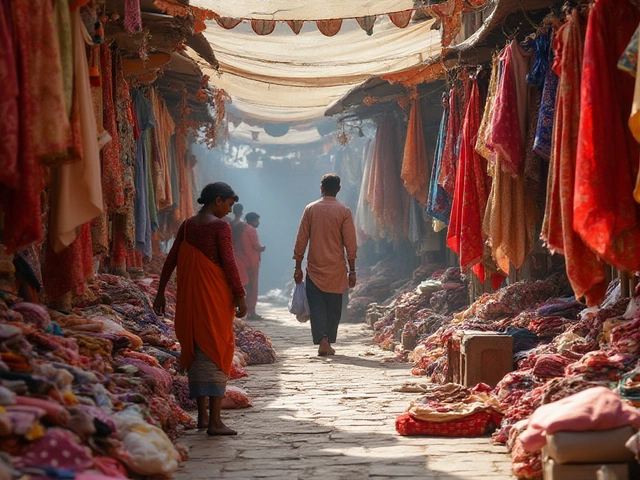If you've ever wondered who calls the shots in India's booming pharma scene, you're not alone. The Indian drug market is fierce, fast-moving, and packed with movers and shakers—yet one name keeps coming back when you look for the biggest of them all: Sun Pharmaceutical Industries.
Sun Pharma isn’t just some big fish in a small pond. They’re a global heavyweight now, having outpaced other Indian drugmakers in everything from revenue to reach. Back in the early 1990s, Sun was just a small company in Vapi, Gujarat. Now, their medicines land on pharmacy shelves in more than 100 countries, and their annual revenue is often above Rs 42,000 crore (that’s nearly $5 billion for anyone keeping tabs).
- India’s Pharma Market at a Glance
- Meet the Largest Drug Manufacturer
- What Makes Them the Biggest
- Not Just Size: Key Strategies and Global Reach
- Tips for Working with Indian Pharma Giants
India’s Pharma Market at a Glance
When people talk about the global pharmacy game, India's top pharma companies are always in the mix. India is actually the third largest producer of medicines by volume in the world. Not bad for a country where modern pharma didn’t take off until the 1970s, right?
If you hear people say "Pharmacy of the World," they’re talking about India. Around 20% of the world’s generic drugs come from here. What’s wild is that Indian manufacturers supply more than 60% of the global demand for vaccines. This isn’t just lip service. Lines of shipping containers filled with everything from fever medicine to cancer drugs leave Indian shores every day.
Here’s a quick breakdown to show how much muscle the market has:
| Stat | Value |
|---|---|
| Annual pharma exports (2024) | $25 billion+ |
| Registered pharma companies | 3,000+ |
| Manufacturing plants (WHO-GMP approved) | 1,400+ |
| Generic drugs share (worldwide) | 20% |
The pharma industry India isn’t just about making bulk generics. The industry covers everything: research, drug discovery, manufacturing active ingredients, finished medicines, and even biotech. All this runs on a workforce of about 3 million people, not counting the indirect jobs it creates.
Why do Indian pharma manufacturers punch above their weight? It comes down to aggressive pricing, huge investments in quality, and global-level regulatory approvals. The FDA has more approved plants in India than anywhere outside the US, and that's no small feat.
Meet the Largest Drug Manufacturer
If you’re scanning the names behind India's top pharma companies, Sun Pharmaceutical Industries wins the title of the largest drug manufacturer India hands down. The company started in 1983, not as some shiny mega-corp but as a small business making just a few psychiatric drugs. Its founder, Dilip Shanghvi, isn’t your classic billionaire—he built Sun Pharma step by step, turning those early medicines into a whole lineup that covers everything from heart pills to eye drops.
Sun Pharma really pulled ahead in 2014, when it acquired Ranbaxy, another major Indian player. That single move shot Sun up the charts, making it not just India's biggest, but also one of the world’s top generics producers. Today, Sun Pharma supplies meds for chronic and acute problems, both branded and generic. Their brands—like Revital, Pantocid, and Volini—are pretty much household names in India.
Check out some quick-fire stats that show why they’re #1:
- Presence in more than 100 global markets, with the US as their largest overseas operation.
- More than 40 factories, spread across India, the US, and a few other countries.
- Over 2,000 products in their portfolio, from simple tablets to complicated injectables.
- Employing nearly 37,000 people worldwide.
| Key Fact | Value (2024) |
|---|---|
| Revenue | Rs 42,000+ crore (~$5 billion) |
| Founded | 1983 |
| Number of Manufacturing Plants | 40+ |
| Countries Served | 100+ |
That’s why when folks talk about pharma manufacturers India, Sun Pharma is the go-to example. They aren’t just selling locally; they’re pushing Indian pharma onto the world stage, leading by sheer scale and reach.

What Makes Them the Biggest
This is where Sun Pharma really stands out in the crowd. It’s not just about pumping out more pills—it’s how they do it and what they’ve built over the years. If you break down their edge, it comes down to a few big things.
- Scale of Production: Sun Pharma runs over 40 manufacturing plants in India and abroad. These aren’t small factories. Some plants are USFDA-approved, which means they can make products for demanding markets like the US and Europe. No surprise, they churn out billions of tablets, capsules, and injectables each year.
- Wide Product Portfolio: You’ll find everything from basic generics to high-end specialty medicines under their belt. They cover key areas like cardiology, psychiatry, neurology, oncology, and diabetes—most of the prescriptions you hear doctors talk about.
- Global Reach: Sun Pharma exports more than 60% of its products. Their US business alone makes up about 30% of their global revenue. They’re not just India’s leader—they’re one of the world’s top generic drug makers.
- Acquisitions and Expansion: Their now-legendary acquisition of Ranbaxy in 2014 is still talked about. That single move made them India’s No. 1 pharma company almost overnight.
- R&D Power: Big players spend big on research, and Sun’s no different. They operate top-notch research centers and invest around 7% of revenue in R&D every year—that’s well above the industry average in India.
To give you a snapshot of just how far ahead Sun Pharma is, check out this quick comparison with other pharma industry India leaders:
| Company | FY 2024 Revenue (INR Crores) | Global Markets |
|---|---|---|
| Sun Pharma | 42,000+ | 100+ |
| Cipla | 23,000 | 80+ |
| Dr. Reddy's | 25,000 | 60+ |
Being at the top isn’t just about revenue or headcount. It’s about a mix of smart strategy, aggressive growth, and a willingness to take risks. Sun Pharma nails all three, making them the go-to name if you’re looking for the largest drug manufacturer India has to offer.
Not Just Size: Key Strategies and Global Reach
Sun Pharma didn’t become the largest drug manufacturer in India by just pumping out pills. They’ve made some bold moves—think smart takeovers, wide research focus, and understanding where the demand actually is. For example, buying Ranbaxy back in 2014 instantly made Sun a major player not just in India, but all over the world.
They’ve got factories everywhere, from Dadra in the west to Halol in the east, plus plants in the U.S., Canada, and Brazil. Being present in so many spots means their products stay in demand and they can squeeze past supply chain headaches faster than smaller companies. Right now, Sun Pharma exports close to 70% of its finished products, which keeps the dollars rolling in and proves they’re much more than just an Indian supplier.
They don’t just sell generics, either. Sun bets big on specialty and complex drugs—the sort that treat everything from chronic skin issues to psychiatric conditions. This is a smart play because these types of medicine are harder to copy and can stay profitable even as regular generics get cheaper.
Here’s a quick look at their global presence:
| Region | Manufacturing Plants | Market Reach |
|---|---|---|
| India | 23 | Dominates |
| North America | 10 | Major supplier |
| Europe | 5 | Steady presence |
| Rest of World | 9 | Across 100+ countries |
Sun’s also quick to adapt their business. When U.S. drug regulators got tougher, they invested heavily in making their plants top-notch and compliant. When digital healthcare took off, they started beefing up their online doctor services and telemedicine offerings. All this combines to keep them at the top of the Indian pharma industry—and anywhere else they want to compete.

Tips for Working with Indian Pharma Giants
If you want to partner up with India's top pharma companies, it’s not just about picking up the phone or sending an email. There’s a method to the madness, and knowing it can save you time, headaches, and a lot of back-and-forth.
First off, Indian pharma giants like Sun Pharmaceutical Industries have pretty structured processes for new business connections. Whether you're hunting for a supplier, looking to license a generic, or hoping to set up a distribution pact, following their playbook helps.
- Do your homework: Learn their core business areas. Sun Pharma, for instance, is big in generics, specialty medicines, and APIs (active pharmaceutical ingredients). Tailor your pitch so it matches their current strategies.
- Understand the paperwork: Indian drug firms take compliance seriously. Expect solid demands for certifications (like US FDA or WHO-GMP), batch records, and detailed product data sheets. Have these ready before you approach.
- Use the right channels: Most large companies prefer you use their official business inquiry forms or contact their business development team directly. Skipping this step often gets your mail tossed aside.
- Negotiate for the long haul: These aren’t just one-off deals. Indian pharma majors look for steady partners. Show them you’re serious about long-term business—think supply reliability and volume commitments, not quick discounts.
- Stay transparent: Direct and clear conversations about pricing, minimum order quantities, intellectual property, and timelines go a long way. No one likes surprises, least of all big pharma players.
It's also worth knowing that Indian drug makers have grown picky over the years. They might ask for references or proof you can meet international standards.
| Requirement | Why It Matters |
|---|---|
| GMP Certification | Shows you meet top manufacturing standards |
| Regulatory Approvals (like US FDA) | Needed for export and entering global markets |
| Financial Strength | Proves you'll stick around and can handle large orders |
| Clear Communication | Avoids misunderstandings and keeps deals moving fast |
Want a smooth experience? Build trust, stay professional, and prove you understand how the largest drug manufacturer in India actually operates. That’s what gets your foot in the door and makes working together a lot easier.









Write a comment